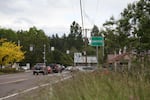
The main intersection in Damascus, at the corner of Foster Road and Highway 212, in Clackamas County. In the past, a city had to get permission from the state to change a speed limit even if the street was owned and maintained by the city.
Allison Frost / OPB
A new state law allows Oregon cities — and some counties — to apply for the authority to designate speed limits on their roads.
In the past, a city dealing with speeding or accidents on their roads had to get permission from the state to change the speed limit, even if the street was owned and maintained by the city.
Also, changing a speed limit was a lengthy process. The Oregon Department of Transportation has only five investigators who can approve speed limit changes for the entire state. This has created a case backlog extending from six months to a year.
Now, the state is allowing all of Oregon’s 241 cities — and Multnomah and Clackamas counties — to start the process of designating their own speed limits.
“Providing local governments with the authority to set their own speed limits should make the process quicker, more effective and more responsive to local needs,” ODOT said in a statement.
Dylan Rivera with the Portland Bureau of Transportation welcomed the news. He said Portland has been trying to pass legislation in Salem for years. The city is already working on the application process to gain control over their speed limits.
“It’ll be easier and faster for us to reduce the speed limit when we’re redesigning a street to make it safer,” said Rivera.
Speed limits indicate the maximum speed considered safe under favorable weather conditions. Speed is a major factor in the severity of injury caused in road crashes.
“Small changes to our speed limit, from 30 to 25, are very important in reducing traffic deaths,” said Rivera.
ODOT said the system is expected to be of particular help in communities of color, which often bear an outsized brunt of highway crashes.
Jurisdictions that apply for the ability to change their speed limits will have to designate an engineer to oversee the process. Smaller cities may have to contract with an engineer. Those engineers will then get training from the state on best practices and state laws.
Oregon roads have statutory and designated speed limits. Statutory speed limits are set by state law, such as 25 mph in residential districts, 20 mph in school zones and 65 mph on most interstates. Designated speed limits, determined by an engineering investigation, can vary.
If a statutory speed limit is deemed inappropriate under the new law, a designated speed limit can be established through an engineering study. The study is based on national standards and reviews of roadway characteristics like traffic, crash history, roadside density and speed limits.
